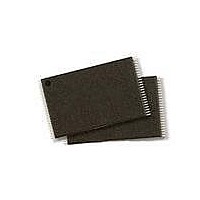S29JL032H70TFI420 Spansion Inc., S29JL032H70TFI420 Datasheet - Page 43

S29JL032H70TFI420
Manufacturer Part Number
S29JL032H70TFI420
Description
IC,EEPROM,NOR FLASH,2MX16/4MX8,CMOS,TSSOP,48PIN,PLASTIC
Manufacturer
Spansion Inc.
Datasheets
1.S29JL032H70TFI420.pdf
(60 pages)
2.S29JL032H70TFI020.pdf
(64 pages)
3.S29JL032H70TFI420.pdf
(66 pages)
Specifications of S29JL032H70TFI420
Data Bus Width
8 bit, 16 bit
Architecture
Boot Sector
Interface Type
Conventional
Access Time
70 ns
Supply Voltage (max)
3.6 V
Supply Voltage (min)
2.7 V
Maximum Operating Current
2 mA
Mounting Style
SMD/SMT
Memory Type
Flash
Memory Size
32 Mbit
Operating Temperature
+ 85 C
Package / Case
TSOP-48
Lead Free Status / RoHS Status
Lead free / RoHS Compliant
Lead Free Status / RoHS Status
Lead free / RoHS Compliant
Available stocks
Company
Part Number
Manufacturer
Quantity
Price
Company:
Part Number:
S29JL032H70TFI420
Manufacturer:
Spansion
Quantity:
2 356
May 21, 2004 S29JL032HA0
Reading Toggle Bits DQ6/DQ2
DQ5: Exceeded Timing Limits
DQ3: Sector Erase Timer
DQ2 toggles when the system reads at addresses within those sectors that have
been selected for erasure. (The system may use either OE# or CE# to control the
read cycles.) But DQ2 cannot distinguish whether the sector is actively erasing or
is erase-suspended. DQ6, by comparison, indicates whether the device is actively
erasing, or is in Erase Suspend, but cannot distinguish which sectors are selected
for erasure. Thus, both status bits are required for sector and mode information.
Refer to Table
7 shows the toggle bit algorithm in flowchart form, and the section “DQ2: Toggle
Bit II” explains the algorithm. See also the DQ6: Toggle Bit I subsection. 23
shows the toggle bit timing diagram. 24 shows the differences between DQ2 and
DQ6 in graphical form.
Refer to 7 for the following discussion. Whenever the system initially begins read-
ing toggle bit status, it must read DQ15–DQ0 (or DQ7–DQ0 for x8-only device)
at least twice in a row to determine whether a toggle bit is toggling. Typically, the
system would note and store the value of the toggle bit after the first read. After
the second read, the system would compare the new value of the toggle bit with
the first. If the toggle bit is not toggling, the device has completed the program
or erase operation. The system can read array data on DQ15–DQ0 (or DQ7–DQ0
for x8-only device) on the following read cycle.
However, if after the initial two read cycles, the system determines that the toggle
bit is still toggling, the system also should note whether the value of DQ5 is high
(see the section on DQ5). If it is, the system should then determine again
whether the toggle bit is toggling, since the toggle bit may have stopped toggling
just as DQ5 went high. If the toggle bit is no longer toggling, the device has suc-
cessfully completed the program or erase operation. If it is still toggling, the
device did not completed the operation successfully, and the system must write
the reset command to return to reading array data.
The remaining scenario is that the system initially determines that the toggle bit
is toggling and DQ5 has not gone high. The system may continue to monitor the
toggle bit and DQ5 through successive read cycles, determining the status as de-
scribed in the previous paragraph. Alternatively, it may choose to perform other
system tasks. In this case, the system must start at the beginning of the algo-
rithm when it returns to determine the status of the operation (top of 7).
DQ5 indicates whether the program or erase time has exceeded a specified in-
ternal pulse count limit. Under these conditions DQ5 produces a “1,” indicating
that the program or erase cycle was not successfully completed.
The device may output a “1” on DQ5 if the system tries to program a “1” to a
location that was previously programmed to “0.” Only an erase operation can
change a “0” back to a “1.” Under this condition, the device halts the opera-
tion, and when the timing limit has been exceeded, DQ5 produces a “1.”
Under both these conditions, the system must write the reset command to return
to the read mode (or to the erase-suspend-read mode if a bank was previously
in the erase-suspend-program mode).
After writing a sector erase command sequence, the system may read DQ3 to de-
termine whether or not erasure has begun. (The sector erase timer does not
A D V A N C E
14
to compare outputs for DQ2 and DQ6.
I N F O R M A T I O N
S29JL032H
43
















